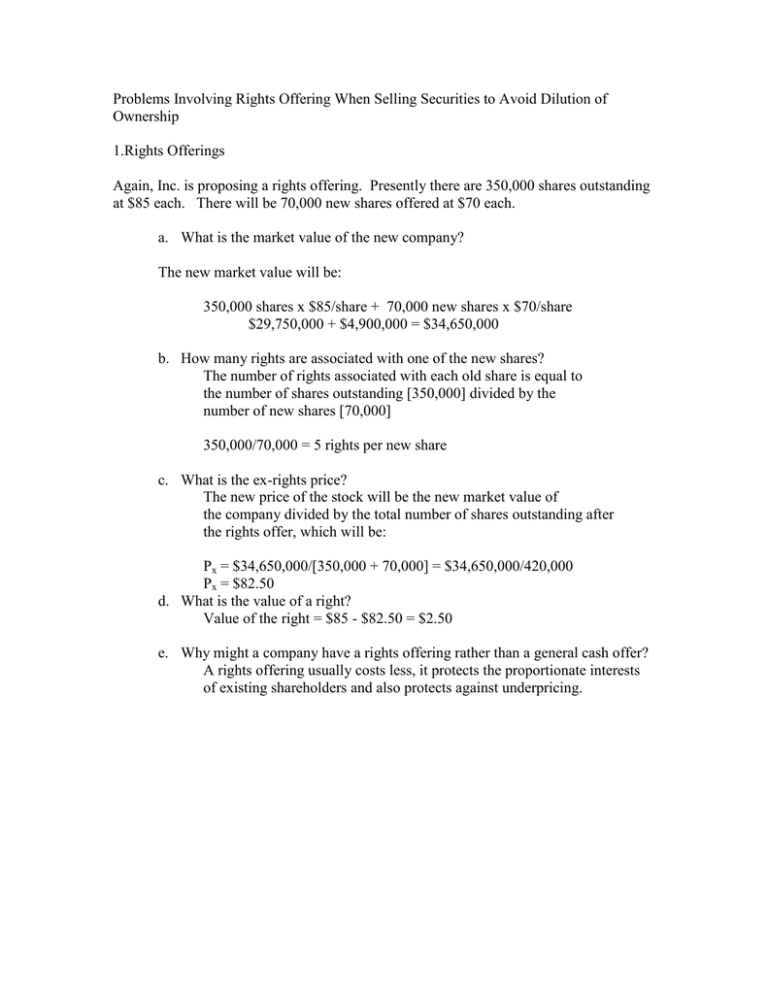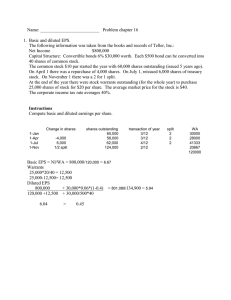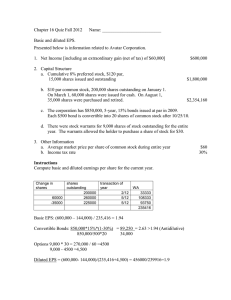Problems Involving Rights Offering and Dilution of Ownership with
advertisement

Problems Involving Rights Offering When Selling Securities to Avoid Dilution of Ownership 1.Rights Offerings Again, Inc. is proposing a rights offering. Presently there are 350,000 shares outstanding at $85 each. There will be 70,000 new shares offered at $70 each. a. What is the market value of the new company? The new market value will be: 350,000 shares x $85/share + 70,000 new shares x $70/share $29,750,000 + $4,900,000 = $34,650,000 b. How many rights are associated with one of the new shares? The number of rights associated with each old share is equal to the number of shares outstanding [350,000] divided by the number of new shares [70,000] 350,000/70,000 = 5 rights per new share c. What is the ex-rights price? The new price of the stock will be the new market value of the company divided by the total number of shares outstanding after the rights offer, which will be: Px = $34,650,000/[350,000 + 70,000] = $34,650,000/420,000 Px = $82.50 d. What is the value of a right? Value of the right = $85 - $82.50 = $2.50 e. Why might a company have a rights offering rather than a general cash offer? A rights offering usually costs less, it protects the proportionate interests of existing shareholders and also protects against underpricing. 5. Calculating Flotation Costs The St. Anger Corporation needs to raise $25 million to finance its expansion into new markets. The company will sell new shares of equity via a general cash offering to raise the needed funds. If the offer price is $35 per share and the company’s underwriters charge an 8% spread, how many share need to be sold? Let X = Number of Required Shares $25 million = X [ $35 (1-.08)] X = $25million/ $35(.72) X = $25 million/25.2 = 992,063.49 Shares 10. Dilution Teardrop Inc., wishes to expand its facilities. The company currently has 10 million shares outstanding and no debt. The stock sells for $50 per share, but the book value per share is $40. Net income for Teardrop is currently $15 million. The new facility will cost $35 million, and it will increase net income by $500,000. a. Assuming a constant price-earnings ratio, what will the effect be of issuing new equity to finance the investment? To answer, calculate the new book value per share, the new total earnings, the new EPS, the new stock price, and the new market to book ratio. What is going on here? The number of shares outstanding after the stock offer will be the current shares outstanding plus the amount raised divided by the current stock price, assuming the stock price doesn’t change. So: Number of shares after the offering = 10 million + $35 million/$50/share [Assuming there is no flotation costs] Number of shares after the offering = 10.7 million Since the par value per share is $1, the old book value of the shares is the current number of shares outstanding. New book value per share = [10 million x $40 + .7 million x $50]/10.7 million = $40.65 The current EPS for the company is: $15 million / 10 million shares = $1.50 The current P/E is: $50/$1.50 = $33.33 If the net income increases by $500,000, the new EPS will be: $15.5 million / 10.7 millions shares = $1.45 per share i.e.., the transaction is dilutive Assuming the P/E remains constant, the new share price will be: (P/E) x (New EPS) = 33.33 x $1.45 = $48.29 i.e., the share price will decline from $50 to $48.29 The current market to book value is: $50/$40 = 1.25 Using the new share price and book value per share, the new market-to-book ratio will be: $48.29/$40.65 = 1.1877 Accounting dilution has occurred because new shares were issued when the market to book ratio was less than 1; market value dilution has occurred because the firm financed a negative NPV project. The cost of the project is given at $35 million. The NPV of the project is the new market value of the firm minus the current market value of the firm or: NPV = -$35 million + [10.7 million x $48.29 – 10 million x $50] = -$18,333,333 b. What would the new net income for Teardrop have to be for the stock price to remain unchanged? For the price to remain unchanged when the P/E ratio is constant, EPS must remain constant. The new net income must be the new number of shares outstanding times the current EPS which gives: NI = (10.7 millions shares) x $1.50/share = $16.05 million



